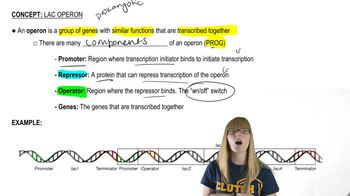The creation of milk products such as cheeses and yogurts is dependent on the conversion by various anaerobic bacteria, including several Lactobacillus species, of lactose to glucose and galactose, ultimately producing lactic acid. These conversions are dependent on both permease and β-galactosidase as part of the lac operon. After selection for rapid fermentation for the production of yogurt, one Lactobacillus subspecies lost its ability to regulate lac operon expression [Lapierre, L., et al. (2002). J. Bacteriol. 184:928–935]. Would you consider it likely that in this subspecies the lac operon is on or off? What genetic events would likely contribute to the loss of regulation as described above?
Table of contents
- 1. Introduction to Genetics51m
- 2. Mendel's Laws of Inheritance3h 37m
- 3. Extensions to Mendelian Inheritance2h 41m
- 4. Genetic Mapping and Linkage2h 28m
- 5. Genetics of Bacteria and Viruses1h 21m
- 6. Chromosomal Variation1h 48m
- 7. DNA and Chromosome Structure56m
- 8. DNA Replication1h 10m
- 9. Mitosis and Meiosis1h 34m
- 10. Transcription1h 0m
- 11. Translation58m
- 12. Gene Regulation in Prokaryotes1h 19m
- 13. Gene Regulation in Eukaryotes44m
- 14. Genetic Control of Development44m
- 15. Genomes and Genomics1h 50m
- 16. Transposable Elements47m
- 17. Mutation, Repair, and Recombination1h 6m
- 18. Molecular Genetic Tools19m
- 19. Cancer Genetics29m
- 20. Quantitative Genetics1h 26m
- 21. Population Genetics50m
- 22. Evolutionary Genetics29m
12. Gene Regulation in Prokaryotes
Lac Operon
Problem 16b
Textbook Question
In the lac operon, what are the likely effects on operon gene transcription of the mutations described in a–e?
Mutation of the repressor binding site on the operator sequence
 Verified step by step guidance
Verified step by step guidance1
Understand the lac operon system: The lac operon in E. coli is a group of genes involved in lactose metabolism. It is regulated by the interaction of the repressor protein with the operator sequence. When the repressor binds to the operator, transcription of the operon genes is blocked. Lactose (or allolactose) acts as an inducer by binding to the repressor, preventing it from binding to the operator and allowing transcription.
Identify the mutation described: The problem specifies a mutation in the repressor binding site on the operator sequence. This means the operator sequence is altered such that the repressor protein can no longer bind to it.
Predict the effect of the mutation: If the repressor cannot bind to the operator, the operon will no longer be repressed, even in the absence of lactose. This results in constitutive expression of the operon genes, meaning they will be transcribed continuously regardless of environmental conditions.
Relate the mutation to gene transcription: Since the repressor is unable to block RNA polymerase from binding to the promoter and initiating transcription, the operon genes (lacZ, lacY, and lacA) will be transcribed at all times.
Summarize the outcome: The mutation in the repressor binding site on the operator sequence leads to a loss of regulation, causing the lac operon genes to be expressed constitutively, regardless of the presence or absence of lactose.
 Verified video answer for a similar problem:
Verified video answer for a similar problem:This video solution was recommended by our tutors as helpful for the problem above
Video duration:
1mPlay a video:
Was this helpful?
Key Concepts
Here are the essential concepts you must grasp in order to answer the question correctly.
Lac Operon Structure
The lac operon is a set of genes in E. coli that are involved in the metabolism of lactose. It consists of three structural genes (lacZ, lacY, and lacA) and regulatory elements, including a promoter and an operator. The operon is controlled by a repressor protein that binds to the operator, preventing transcription when lactose is absent.
Recommended video:
Guided course

Lac Operon Overview
Repressor Protein Function
The repressor protein is crucial for regulating the lac operon. It binds to the operator region of the operon, blocking RNA polymerase from transcribing the downstream genes. When lactose is present, it binds to the repressor, causing a conformational change that releases the repressor from the operator, allowing transcription to occur.
Recommended video:
Guided course

Proteins
Mutations and Their Effects
Mutations in the repressor binding site on the operator can significantly affect gene transcription. If the binding site is altered, the repressor may not bind effectively, leading to constitutive expression of the operon genes regardless of lactose presence. This can result in the continuous production of enzymes needed for lactose metabolism, even when lactose is not available.
Recommended video:
Guided course

Maternal Effect
Related Videos
Related Practice
Textbook Question
731
views


